In our last fireside chat, we covered a very exciting topic on growth strategies for early-stage industrial IoT startups. We caught up with our guest, Raj Joshi, on 17th Jan 2023, who has a rich entrepreneurial experience around innovative growth businesses, AI, and strategic management. Raj was a partner with Delloite, having founded the Delloite Global Technology Subsidiary in India, and subsequently the co-founder of Infosys consulting. He has also founded Noodle.ai, an AI and IoT solutions company and currently he teaches strategy at the Stanford Graduate School of Business.
In conversation with C Ravi, Raj presents his point of view on growth strategies using a set of well-devised and incisive frameworks.
The Trends Providing the Growth Headwinds for Startups
First up, Raj stresses the requirement for every startup to grow, as growth in terms of revenue, and customers is a fantastic validation of the startup's products, and in reality, their company's existence. As a precursor to delving deeper into growth strategies, there are two things that Raj emphasizes.
First is macro technology trends, such as industrial IoT, and IoT in general, that creates enormous economic value for those who play in that space. Raj cites the example of ERP systems during the 90s, which were the rage, and SAP and Oracle did a fantastic job of convincing fortune 1000 companies of implementing an integrated ERP system. And the same thing followed from ERP, to Software-as-a-Service, Cloud Computing, Analytics, IoT, and now AI.
The second point highlighted by Raj is the global nature of these macro trends, and IoT is no exception to that. So it's not about just focusing on the Indian market, but also considering how to target the global market, because that’s what changes the game for entrepreneurs.
Growth Projections for IIoT Startups
Raj presented some data on the growth trajectory of the IIoT market, as sourced from some credible sources on the Internet.
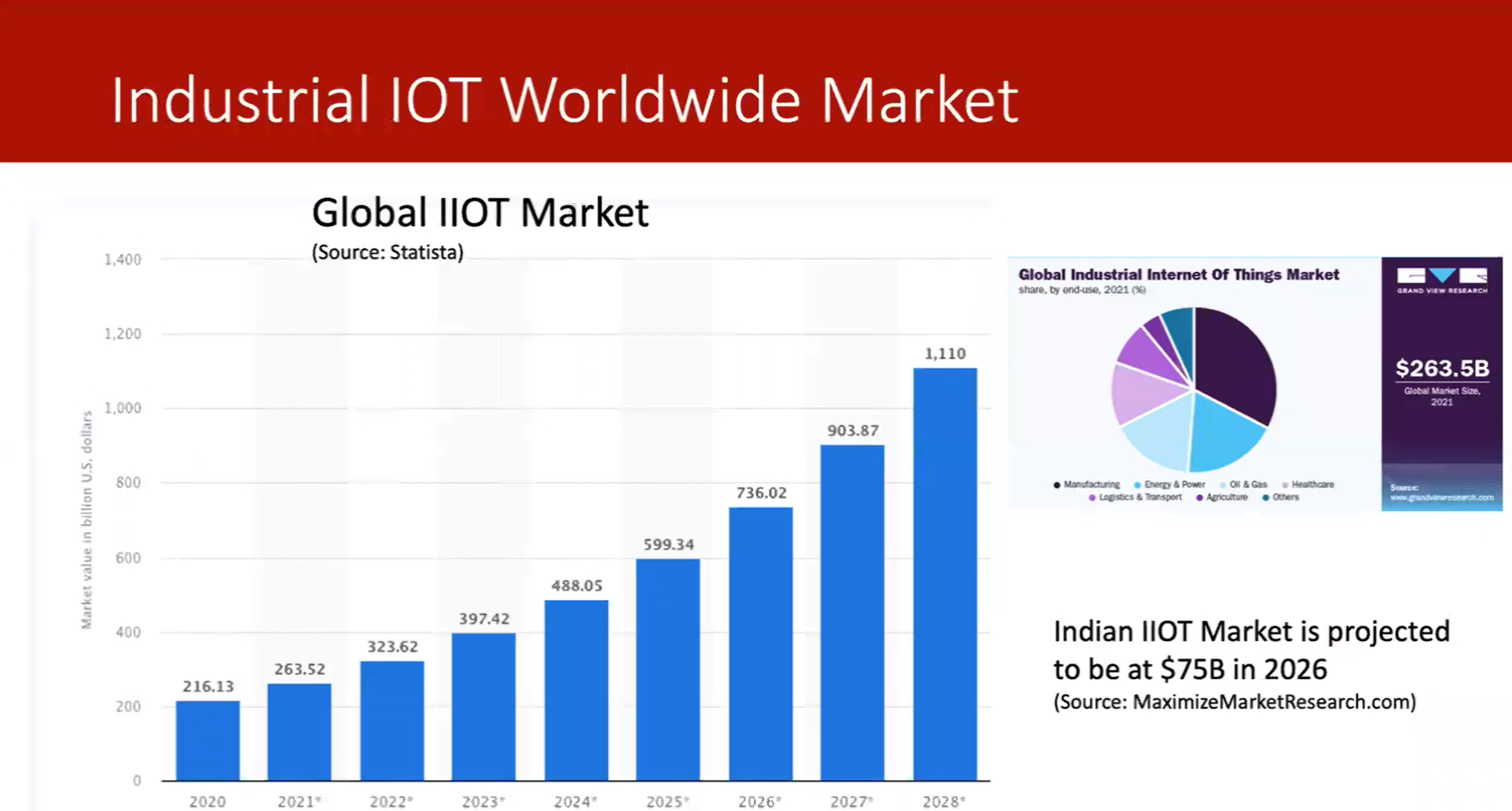
As per Raj, there are three key takeaways from this data:
- The IIoT market is projected to grow to $1.1 Trillion by 2028. This means that about 700 billion dollars will be incrementally added from the current levels of $323 Billion at the end of 2022. So the next six years are expected to add a lot of cumulative value. For IIoT startups, capturing even 1 % of that amount is significant for their growth.
- The pie chart indicates that the macro trend for IIoT is evenly spread across all the major industries, such as manufacturing, Energy & Power, Agriculture, and so on.
- By 2026, the Indian IIoT market is projected to be at $75 Billion, which is 10% of the global market.
The Seven Strategic Imperatives of Growth
Raj highlights seven strategic imperatives for growth. And this is not specific to IIoT but applicable to any startup.
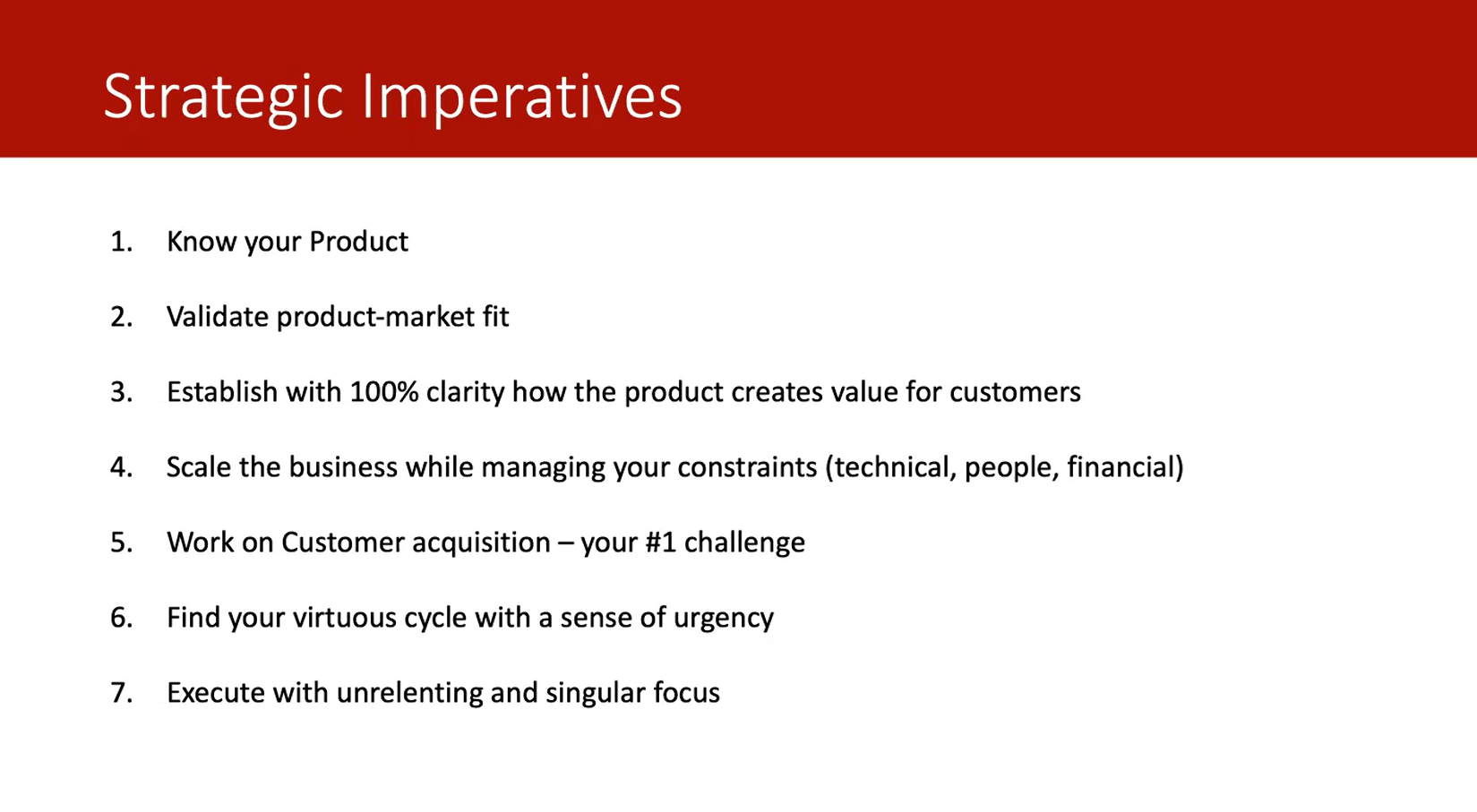
These are arranged in an additive sequence, such that the previous one is a dependency on the next. So Raj’s advice is to work them out in the same sequence as it is mentioned.
The first imperative, “Know your Product” is the most fundamental imperative. Without it, the game is over before it starts. Next comes the step of “Validating Product Market Fit”. As per Raj, this is the founding block for growth. As Raj aptly puts it, product market fit is something that makes a customer say, I want to buy your product because it fulfills my needs or requirement. When a startup has 30 customers who say this and buy from them, it is a sure-shot sign of product market fit.
The third imperative, “Establish with 100% clarity how the product creates value for the customer”, becomes very critical when a startup must have complete clarity on how their product delivers value to customers. As per Raj, many startups get blocked at this stage. If a startup knows about it, it allows them to build upon it and move to scale, which is the fourth imperative, “Scale the business while managing your constraints”. Scaling up along with managing the constraints is the key to the long-term success of a startup.
Post the stages of figuring out the value proposition and scaling, the most important challenge is to “Work on customer acquisition”. Cracking this challenge puts the startup in a league of the virtuous cycle. “Find your virtuous cycle with a sense of urgency” creates the flywheel effect, wherein the product is established in the market and starts selling itself. And that's where “Execute with unrelenting and singular focus” comes into the picture. This is the perennial execution challenge that strives to make the flywheel spin faster.
The Virtuous Cycle
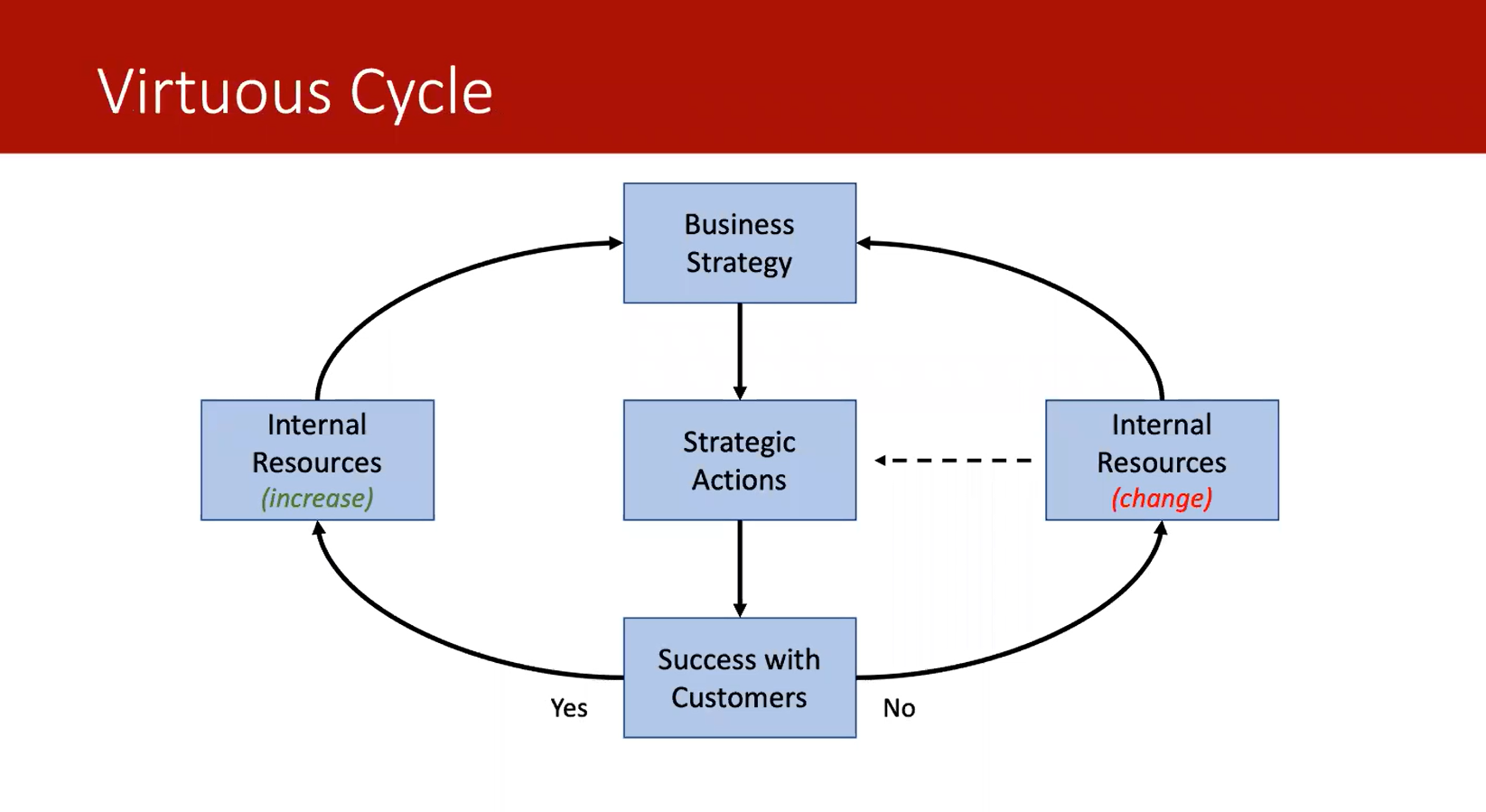
Elaborating on the Virtuous cycle, Raj has a framework as depicted above. This is quite self-explanatory if one follows the vertical line starting from “Business Strategy”, to “Strategic Actions” and “Success with Customers”. And based on the outcome of success with the customer, one can take a right or left path to calibrate the internal resources and repeat the cycle.
Raj emphasizes that strategy is an important consideration, even though it might seem premature in the context of a startup. Strategy provides the roadmap based on structured thinking along with data, and the deliverable is a list of strategic actions. This list serves as the game plan, or as Raj calls it the “Minimum Winning Plan”. And once the strategic actions are put into execution the key metric emerges in the form of success with customers. If the metric moves towards green, it will lead to increasing quarterly or annual revenues being achieved. This is a favorable environment for a startup to invest more resources to grow the business.
But if the startup does not get success with customers, then it's time to take difficult decisions as Raj points out. It might be about rethinking the internal resources or maybe even changing the business strategy and strategic actions. This is a situation like the Brownian motion, as per Raj, where the startup is directionless.
While the approach of following the strategic imperatives to build the virtuous cycle may sound a bit daunting, Raj breaks it down into three easy steps for startups:
- Hold one person accountable for the performance of the virtuous cycle.
- Measure everything concerning the strategic imperatives that can provide some indications about the health of the virtuous cycle.
- Take the entire team into confidence and explain to them the specifics of the strategic actions and their resulting impact on the virtuous cycle.
Strategy Dilemma for IIoT Startups
Raj concurs that in the case of IIoT startups, the strategy takes a very important role, since an IIoT deployment has lots of moving things, unlike SaaS startups. Some of the key strategic considerations as highlighted by Raj are:
- Vertical or Horizontal Focussed: Many IIoT startups get into the vicious cycle of customizing their product for every shop floor. This is detrimental to their product vision, and they end up as system integrators or service companies. Instead, if they focus on a very niche vertical offering, they can expect much better repeatability, which results in better gross margins.
- Hardware vs Software Play: This is another dilemma for IIoT startups since many solutions are increasingly becoming software-centric, which is much more lucrative, while the dependency on hardware is still there, as all the data has to come from sensors.
- Direct selling vs Enlisting Channel Partners: Direct selling can be hard for IIoT startups at an early stage, so targeting potential partners who can position their products and solutions is a viable alternative to crack some inroads into global customers.
- Traditional vs Emerging Opportunities: While many IIoT startups get into a rut of serving traditional industries, there are a lot of emerging trends. One such trend is sustainability, which is a huge huge opportunity, and IoT/IIoT startups have a big role to play in it over the next few years.
There is no silver bullet to deciding which of the above approaches to consider. That’s where Raj repeatedly emphasizes that it is absolutely essential for every startup to have a strategy to figure out these directions early on. This is even more important when a startup is in a situation where founders are hunting for any customer that pays so that they get to revenues. This is a very short-term focussed approach which eventually leads to failure. Instead, the startup founders should take a step back, and dedicate one week to a strategic intervention session to streamline the focus and establish a discipline. This can be achieved through rigorous thinking, intuition, and data points, in consultation with investors and advisors.
Productivity / Economic (Efficiency) Frontier
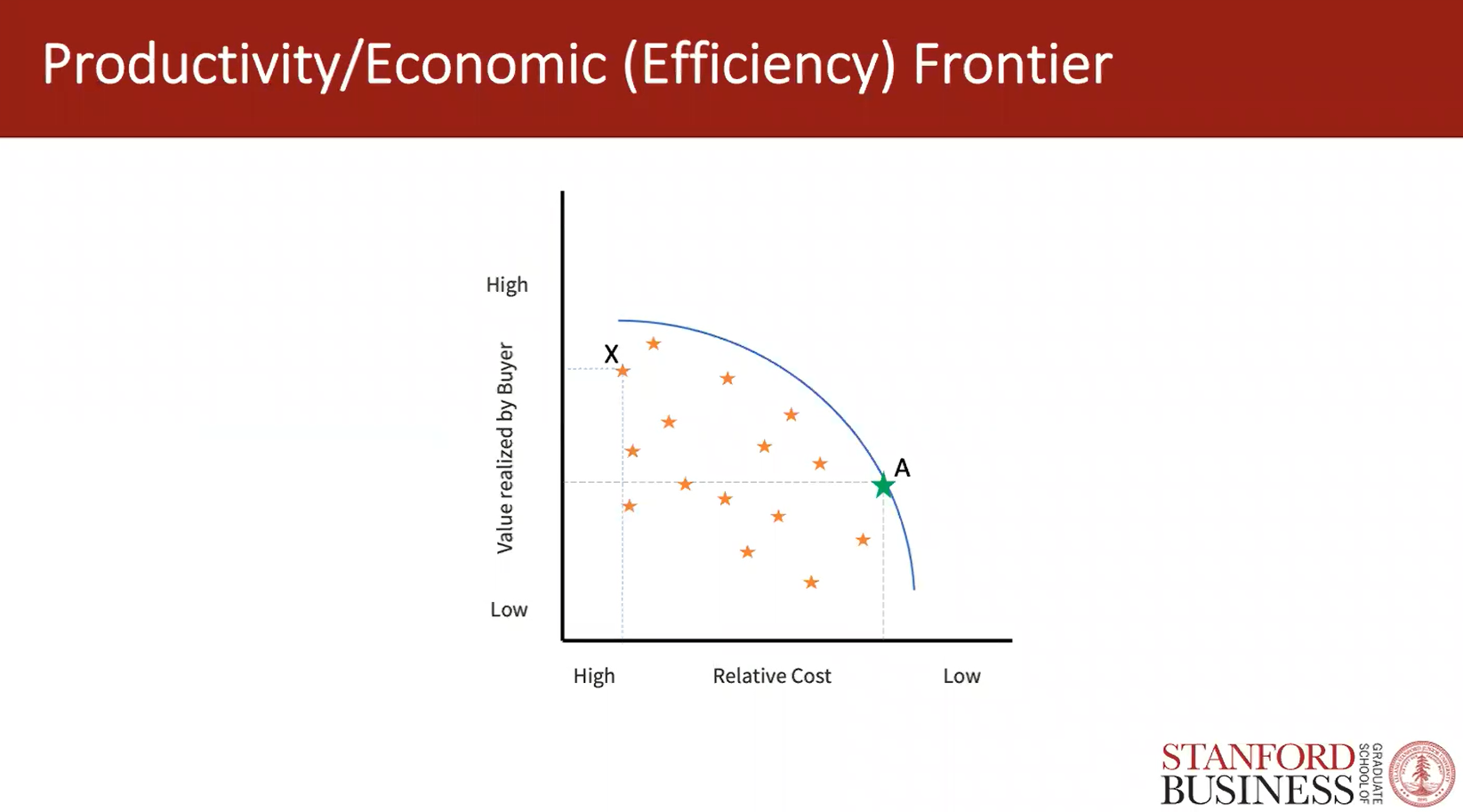
Raj’s final framework is the productivity/economic frontier. He explains it as follows, with reference to the above graph:
The x-axis is the relative cost of the product or service. It goes low to high, right to left direction, in the axis. The y-axis is the perceived value by the buyer. It goes low to high, in the bottom to top direction along the axis.
The curve in blue is the efficiency frontier and every company operates either on the curve or below. To explain this, there are two labels X and A representing two companies. Company X is operating at a higher cost and delivering equally higher value, but not operating at optimum efficiency. Similarly, company A is on a relatively lower cost-to-value proposition but is on the blue curve, therefore operating in optimum efficiency. So the big question here is: how does a company figure out where they are in this curve?
Raj admits this requires a bit of subjective assessment to determine where a company is placed in this curve. The key is to figure this out through some structured thinking, and feedback from customers about product/service, coupled with knowledge about competitors. Regular market feedback indicating whether the startup is consistently being beaten by competitors or consistently winning the deals also adds value to position them in this graph. Once a startup establishes its place in the efficiency frontier, then the next step is to push the frontier out.
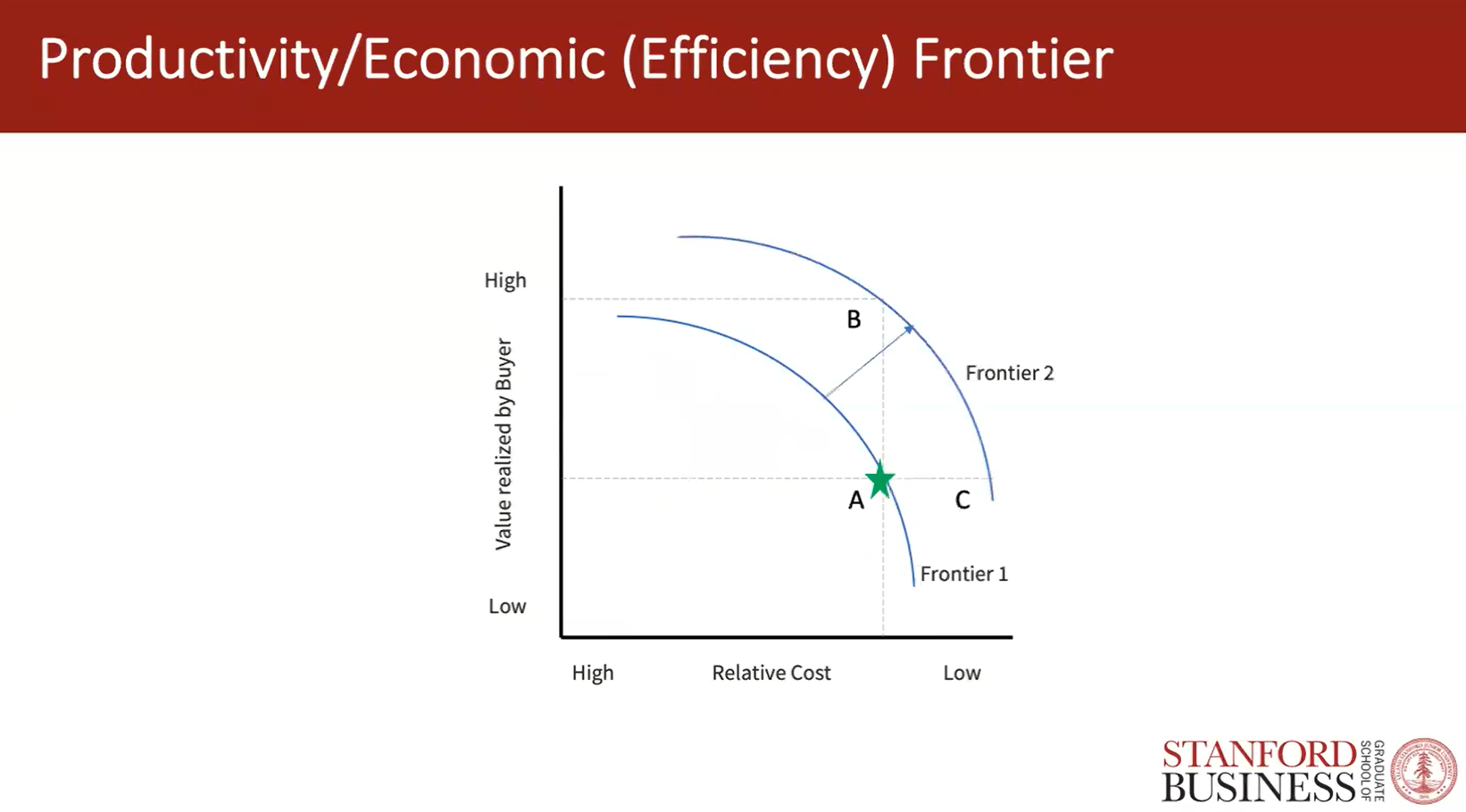
Once a startup can achieve this, it can be safe to assume that the startup will win more than its fair share of deals. It's game over for the competitors. But over time competitors can catch up on this new efficiency frontier.
Raj highlights the three labels A, B, and C in the above graph. Any startup going from A to B will deliver significantly higher value at the same cost. Similarly, moving from A to C means that the same value is delivered to customers at a significantly lower cost.
So how does a startup or a company do that? Raj recommends a few key tenets for achieving such a leap in the efficiency frontier. Mainly it is driven by innovation, an innovative mindset with a world-class product team, and most importantly it's all about thinking differently in terms of delivering more value. Another way to achieve this is by changing the rules of the game. A startup that can do it will definitely drive growth. Co-creation with customers, building relationships, and forging partnerships are all part of this effort.
On behalf of the TiE MatrixForum, Industrial SiG, we thank Raj for his assessment of the IIoT landscape and in-depth framework-driven approach to tracking growth. You can follow Raj on Linkedin and connect with him for any specific questions.
